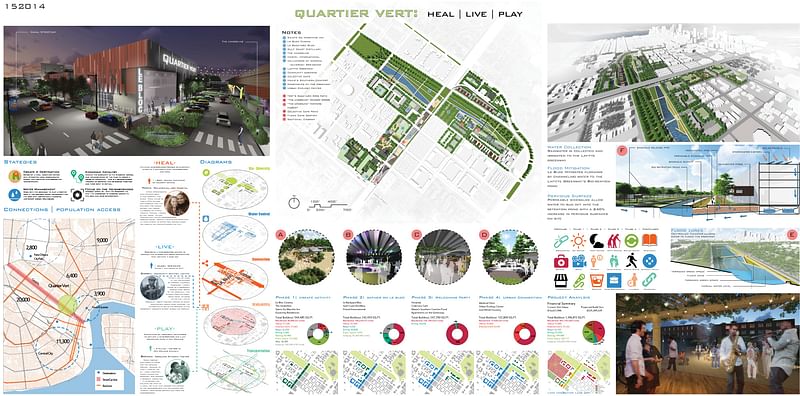Four graduate-student finalist teams for the 2015 ULI/Hines competition
By Bustler Editors|
Thursday, Mar 19, 2015

Related
Four graduate student teams were selected to advance into the last round of the 13th annual Urban Land Institute/Gerald D. Hines 2015 competition. Multidisciplinary graduate student teams are challenged to propose a comprehensive development + redevelopment program for a designated U.S. metro area. While the competition presents hypothetical situations, this year's competition simulates an actual urban design+development scenario in parts of the Tulane/Gravier and Iberville neighborhoods in downtown New Orleans.
Out of 120 teams from 60 North American universities, the four finalist teams are:
- Harvard University: “Claiborne Grove”
- Harvard University: “Tremé 2.0”
- University of Maryland: “The Crossing”
- University of Wisconsin - Milwaukee and University of Wisconsin - Madison: “Quartier Vert”
In the coming weeks, the finalist teams can expand on their initial ideas. A member of each team will then be brought to New Orleans to tour the site and revise their presentation. Teams will present their schemes to the jury during a public forum on April 9, and the winning team will be announced at the end of the event.
The winner will win $50,000, while the three finalist teams receive $10,000 each.
About the designated competition site:
"The Tulane/Gravier and Iberville neighborhoods, which make up a historically rich area in the city’s core, contain a mix of residential, industrial and commercial zoning that includes manufacturing plants and other small industrial complexes, many defunct, others still operational. The competition scenario is based on a hypothetical situation in which community stakeholders, including residents, land owners, local businesses, and others in the area bound by the upcoming Lafitte Greenway, the eastern edge of the new medical district, and crossed by the elevated I-10 highway, have come together to create the North Claiborne Neighborhood Improvement Association (NCNIA) – a fictional entity created for the purpose of the competition.
NCNIA is seeking a master plan proposal that not only transforms the area into a thriving urban neighborhood, but also highlights its locational advantages, including its proximity to the French Quarter, adjacency to the medical district, and interaction with the Lafitte Greenway."
Harvard University: “Claiborne Grove”

Project summary: "Inspired by the architectural and cultural heritage of the project site and its adjacency to major city destinations and amenities, “Claiborne Grove” recalls the rich landscape that once characterized North Claiborne Avenue and prioritizes redevelopment of the street most critical to the growth and transformation of the neighborhood. The proposal’s central design element is 'the Grove,' a linear multi-purpose park and urban landscape sited below elevated Interstate 10."
Harvard University: “Tremé 2.0”

Project summary: "The project “Tremé 2.0” lays at the southern tip of the old Tremé district, one of New Orleans’s first urbanized neighborhoods outside of the Vieux Carre Rampart. The proposed 23-acre development project anticipatesTremé continuing its great tradition of making innovative transformation to the Crescent City, as it did 200 years ago."
University of Maryland: “The Crossing”

Project summary: "'The Crossing' development sows the seeds of resilience across the Bienville, Iberville, and Lafitte neighborhoods. By connecting tourist and native, greenway and park, neighborhood and city, The Crossing functions not only as a marketplace of goods, but of ideas and relationships. This commingling of people and place fosters diversity, neighborhood cohesion, and economic opportunity."
University of Wisconsin - Milwaukee and University of Wisconsin - Madison: “Quartier Vert”

Project summary: "'Quartier Vert' creates a vision of a community that operates as an intersection between communities, corridors of activity, and a variety of users. Intertwined within each of these strategies exists a neighborhood fabric that suggests the interaction between the site and its neighbors. Capitalizing on the existing locational and socioeconomic advantages of the area, Quartier Vert seeks to revive and enhance the surrounding community."

Share
0 Comments
Comment as :